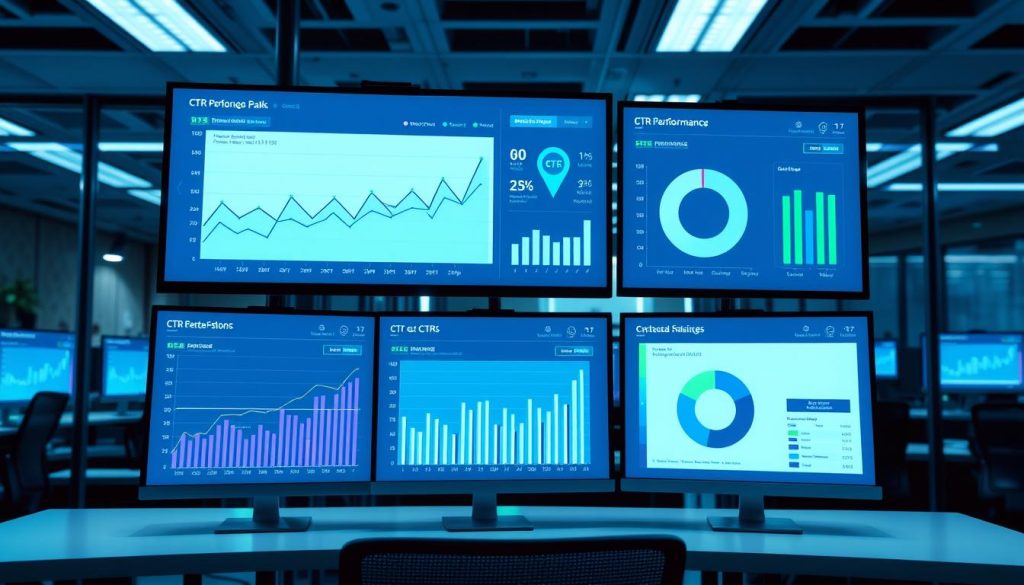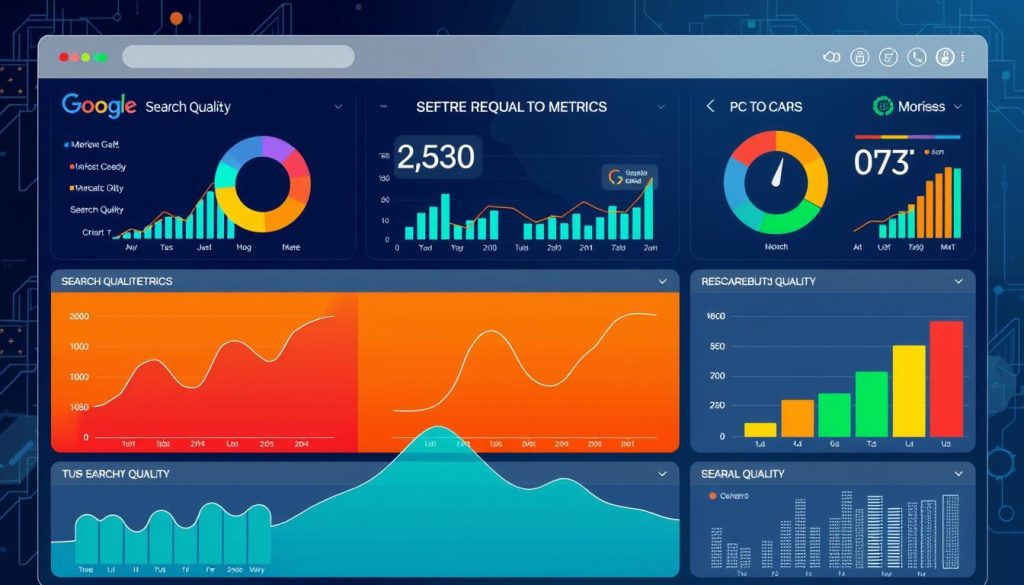Digital marketing success relies on engaging your target audience. Click-through rate (CTR) optimization is crucial for improving search rankings and organic traffic. This guide explores CTR manipulation SERPSEO techniques to boost your online visibility.
Understanding CTR’s impact on search algorithms can unlock new opportunities. We’ll examine CTR’s role in search visibility and explore ethical strategies to enhance it.
Key Takeaways
- Discover the impact of click-through rate (CTR) on search engine rankings and how to leverage it for improved visibility.
- Explore ethical techniques for CTR optimization that align with search engine quality guidelines.
- Understand the importance of user intent targeting and content relevance for enhanced CTR.
- Uncover on-page and off-page SEO strategies to boost click-through rates and drive more organic traffic.
- Learn how to monitor and measure CTR performance using reliable analytics tools.
Understanding Click-Through Rate (CTR) and Its Impact on Search Rankings
Click-through rate (CTR) is a key metric in search engine optimization. It measures how often users click your search result. CTR can significantly influence your website’s search rankings and visibility.
What is CTR and Why Does it Matter?
CTR indicates how relevant and attractive your web content is to users. A high CTR tells search engines that your content is valuable. This can lead to better search rankings.
A low CTR might suggest your content doesn’t meet user needs. This could cause a drop in your search visibility.
Google’s Perspective on CTR as a Ranking Factor
Google recognizes CTR as an important ranking factor. It provides insights into user behavior and preferences. Search engines use CTR to understand which results are most useful to users.
Optimizing for a higher CTR can boost your website’s ctr manipulation serpseo. This strategy can improve your search rankings.
“CTR is a critical factor in determining search engine rankings, as it directly reflects the user’s perception of the relevance and quality of your web content.”
CTR plays a crucial role in determining search engine rankings. It reflects how users perceive your content’s relevance and quality. Improving your CTR can greatly impact your search rankings.
Create compelling content that resonates with your target audience. This can boost your click-through rate and enhance your position in the google ranking factors.
Analyzing User Intent and Search Query Relevance
Understanding user intent is crucial in SEO. It helps improve search quality metrics and click-through rates. By aligning content with audience needs, you can enhance user experience.
User intent targeting identifies motivations behind searches. Are users seeking information, making purchases, or exploring topics? Knowing these patterns helps tailor content to meet audience needs.
Content relevance is vital for SEO success. Provide comprehensive and authoritative information that addresses user queries. This improves user experience and signals value to search engines.
| User Intent | Search Query Examples | Content Recommendations |
|---|---|---|
| Informational | “How to change a tire”, “Best restaurants in New York” | Provide detailed, step-by-step guides, or in-depth reviews and recommendations |
| Transactional | “Buy “, “Where to purchase “ | Highlight product features, pricing, and purchase options, with clear calls-to-action |
| Navigational | “Company name”, “Brand “ | Ensure your website and brand information are easily accessible and optimized |
Catering to diverse user intents improves content relevance. This approach helps create content that resonates with your audience. It also aligns with search engine quality standards, boosting visibility in results.

ctr manipulation serpseo
SEO experts are talking about click-through rate (CTR) manipulation. Some try risky tactics to boost rankings. But there’s an ethical way to improve your CTR.
We’ll explore how to ethically optimize your CTR. We’ll also discuss the dangers of manipulative practices.
Ethical Techniques for CTR Optimization
You can boost your CTR without breaking rules. Here are some ethical ways to improve your online presence:
- Crafting compelling and relevant title tags and meta descriptions that accurately reflect your content.
- Optimizing your content to match user intent and search query relevance.
- Ensuring your website is mobile-friendly and fast-loading for a seamless user experience.
- Leveraging schema markup to provide rich snippets and enhance your SERP visibility.
- Fostering a strong brand identity and building backlinks to increase trust and authority.
Risks and Pitfalls of Manipulative Practices
Ctr manipulation serpseo tactics might seem tempting. But they can lead to serious problems. Search engine penalties and reputation damage are real risks.
Here are some practices to avoid:
- Buying or exchanging fake clicks to inflate your CTR artificially.
- Using misleading or clickbait-style titles and descriptions that do not accurately represent your content.
- Employing ctr manipulation serpseo techniques that violate search engine guidelines, such as cloaking or keyword stuffing.
- Neglecting the overall user experience and focusing solely on short-term CTR gains.
Focus on ethical optimization to build a strong online presence. This approach aligns with search engine rules. It also gives real value to your audience.
On-Page SEO Strategies to Enhance CTR
On-page SEO can boost your click-through rates (CTR) from search results. Compelling title tags and meta descriptions attract users to your site. This improves search rankings and drives more qualified traffic.
Optimizing Title Tags and Meta Descriptions
Title tags and meta descriptions create first impressions in search results. Make them reflect your page’s content and appeal to your audience. Use relevant keywords without stuffing.
Craft eye-catching titles and descriptions that show your page’s value. Keep them accurate and engaging to increase clicks.
Creating Compelling and Relevant Content
Quality content is key to improving CTR. Create informative and engaging material that meets your audience’s needs. Use keywords naturally while focusing on readability and user experience.
Keep your content fresh and valuable. Regular updates will maintain its relevance and appeal to visitors.
“Optimizing your on-page SEO factors, such as title tags, meta descriptions, and content, can have a significant impact on improving your website’s click-through rates from search engine results pages.”
These on-page SEO strategies can make your content stand out in search results. They’ll drive more qualified traffic to your site and boost your search performance.
Off-Page SEO Tactics for Better Click-Through Rates
Off-page SEO tactics can boost your click-through rates (CTR). Link building and brand awareness improve search engine visibility. These strategies attract more engaged users to your website.
Link Building and Brand Awareness
A strong link profile is crucial for increasing CTR. High-quality backlinks from authoritative websites improve search engine rankings. They also show users that your content is trustworthy and valuable.
Guest blogging, influencer outreach, and broken link building help create a diverse link portfolio. These strategies can significantly improve your website’s authority and visibility.
Focusing on brand awareness also boosts CTR. Create and share compelling content regularly. Engage with your audience on social media.
Build a recognizable brand identity to increase clicks on search results. This leads to higher CTR and improved search engine visibility over time.
| Off-Page SEO Tactic | Benefits for CTR |
|---|---|
| Link Building | Improved search engine rankings, increased trust and credibility |
| Brand Awareness | Higher user engagement, better brand recognition in search results |
Combine link building and brand awareness to boost your website’s CTR. These off-page SEO tactics drive more engaged traffic to your content.
Monitoring and Measuring CTR Performance
Successful SEO demands constant attention and data-based choices. Monitoring your click-through rate (CTR) is vital for improving search rankings. Regular performance checks help you make smart decisions.
Google Search Console and Other Analytics Tools
Google Search Console is a powerful, free tool. It shows how your site performs in Google searches. You can see which pages and keywords get the most clicks.
Other helpful tools include Google Analytics, Ahrefs, and Semrush. These offer rich data and reports. They help you make data-driven optimization choices for your website.
| Tool | Key Features for CTR Monitoring |
|---|---|
| Google Search Console |
|
| Google Analytics |
|
| Ahrefs |
|
Regular CTR data analysis across these tools is key. It helps you make smart choices to boost rankings. This approach drives more qualified traffic to your website.

User Experience Optimization for Improved CTR
Enhancing user experience is vital for CTR manipulation SERPSEO. Optimizing mobile-friendliness and page speed creates a seamless experience for visitors. This can boost click-through rates and search engine rankings.
Mobile-Friendliness and Page Speed
Most web searches happen on mobile devices. It’s crucial to optimize your website for mobile users. Google’s search quality metrics favor mobile-friendly sites.
A responsive, mobile-optimized design can greatly improve user experience and click-through rates. Fast-loading pages boost user satisfaction and search engine rankings.
Image compression, code minification, and CDN implementation can optimize your website’s page speed. These techniques work together to enhance overall performance.
- Ensure your website is mobile-friendly and responsive across all devices
- Optimize images, scripts, and other resources to improve page load times
- Leverage tools like Google’s PageSpeed Insights to identify and address speed-related issues
- Consider implementing a CDN to deliver content more efficiently to your users
Focus on user experience, mobile optimization, and page speed. This approach creates an engaging and efficient website. It captivates your audience and boosts click-through rates.
“The best way to improve your CTR is to create a website that is easy to navigate, loads quickly, and provides a seamless experience for your users.”
Aligning Content with Search Quality Metrics
Search engine optimization requires aligning content with search quality metrics. These metrics assess relevance, usefulness, and user experience of your content. They drive the rankings of your web pages.
Focus on creating content that caters to user intent. Understand your audience’s search queries and craft content addressing their needs. This approach will improve your search engine rankings.
- Conduct thorough keyword research to identify the search terms and phrases that are most relevant to your audience.
- Analyze the search intent behind these keywords, whether they are informational, navigational, or transactional in nature.
- Develop content that is tailored to the specific needs and interests of your target users, providing them with valuable and engaging information.
Optimize your content for search engine algorithms. Stay informed about the latest updates. Adjust your content strategy to match these changes.
| Search Quality Metric | Description | Optimization Strategies |
|---|---|---|
| Content Relevance | Measures how well your content aligns with the user’s search query and intent. | Conduct keyword research, create user-centric content, optimize on-page elements. |
| User Experience | Evaluates the overall experience a user has when interacting with your content. | Ensure mobile-friendliness, optimize page speed, provide engaging and informative content. |
| Search Engine Algorithms | Reflects the constantly evolving criteria used by search engines to rank web pages. | Stay informed about algorithm updates, adapt your content and SEO strategies accordingly. |
Aligning content with search quality metrics can improve click-through rates. It can also boost search engine rankings. This approach delivers a better experience for your audience.
Quality content drives more qualified traffic to your website. It meets user needs and search engine standards.

“The key to success in search engine optimization is to create content that truly resonates with your target audience, while also meeting the evolving standards set by search engine algorithms.”
Adapting to Search Engine Algorithm Updates
Search engines often update their algorithms. It’s vital to adapt your strategies to maintain visibility and click-through rates. Staying ahead in SEO is crucial for online success.
Staying Ahead of the Curve
Future-proof your online presence with these key tactics:
- Monitor search engine algorithm updates: Stay informed about changes to algorithms like Google’s. These updates can greatly affect your rankings and CTR.
- Prioritize content quality and relevance: Create high-quality, informative content. Make sure it aligns with user intent and search engine quality metrics.
- Optimize for mobile-friendliness and page speed: Ensure your website works well on all devices. Search engines now favor mobile-friendly and fast-loading pages.
- Embrace a data-driven approach: Use tools like Google Search Console to track your performance. Analyze CTR, search visibility, and other key indicators.
- Remain flexible and adaptable: Be ready to change your tactics as the search landscape evolves. Embrace new SEO best practices to future-proof your online presence.
Stay vigilant and put user experience first. This approach will help you navigate algorithm updates effectively. You’ll maintain your competitive edge in the long run.
“The key to staying ahead of the curve in SEO is to be proactive, data-driven, and constantly adapt to the changing landscape of search engine algorithms.”
Conclusion
This guide explored ctr manipulation serpseo strategies to boost your website’s search rankings. Understanding click-through rate (CTR) is key to improving search performance. With these insights, you can create a powerful SEO approach for lasting results.
Success comes from ethical CTR optimization techniques. Craft compelling titles and meta descriptions. Create engaging, relevant content. Build a strong online presence through strategic link building. Focus on brand awareness to stand out.
Avoid manipulative practices that can harm your website’s future. Stay up-to-date with algorithm changes. Prioritize user experience in your search engine rankings efforts. By focusing on value, you’ll boost organic traffic growth.
Your brand can become a trusted industry resource. Keep adapting and improving your SEO strategy. Remember, user satisfaction is the ultimate goal in search optimization.





